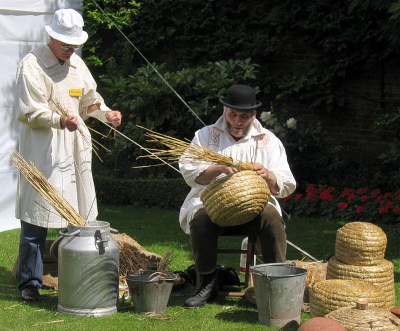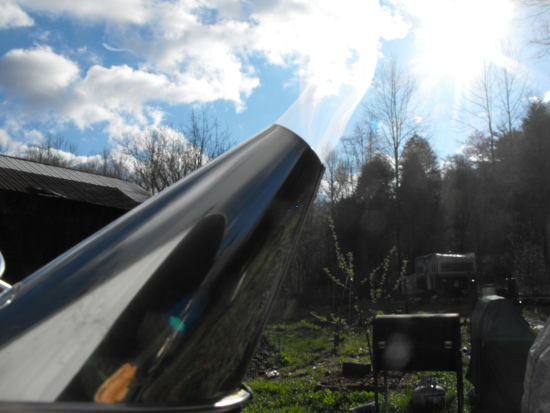
Historical beekeeping hardware
 When honeybees came to America, they were brought across the ocean in straw skeps. In Bees in America,
Horn explains that these skeps were originally considered an innovation
in Europe since they replaced heavier logs and clay plots that were
difficult to move. Horn's book includes some interesting
illustrations of how skeps were constructed, and I was especially
intrigued to learn that ekes were often placed underneath skeps when the
bees needed more room, a bit like nadiring a Warre hive.
When honeybees came to America, they were brought across the ocean in straw skeps. In Bees in America,
Horn explains that these skeps were originally considered an innovation
in Europe since they replaced heavier logs and clay plots that were
difficult to move. Horn's book includes some interesting
illustrations of how skeps were constructed, and I was especially
intrigued to learn that ekes were often placed underneath skeps when the
bees needed more room, a bit like nadiring a Warre hive.
In addition to skeps,
early American beekeepers were fond of bee gums --- hollow logs used as
hives. Even though the inventor of the Langstroth hive (the
primary beekeeping box today) was an American, Horn reports that
colonists continued using bee gums and skeps long after the Langstroth
hive took over in Europe. Since skeps and bee gums don't allow for
much inspection and manipulation, their use may be one reason the U.S.
saw such a rash of pest and disease problems (which I'll cover in a
later post).
 Speaking
of the Langstroth hive, it was one of four inventions that changed the
face of beekeeping in America between 1851 and 1873. During that
period, the bellows smoker, the movable frame hive, wax foundation, and
the centrifugal extractor (along with advances in queen rearing) changed
beekeeping from a hobby into an industry. More on the changing
face of beekeeping in America is to come in tomorrow's post.
Speaking
of the Langstroth hive, it was one of four inventions that changed the
face of beekeeping in America between 1851 and 1873. During that
period, the bellows smoker, the movable frame hive, wax foundation, and
the centrifugal extractor (along with advances in queen rearing) changed
beekeeping from a hobby into an industry. More on the changing
face of beekeeping in America is to come in tomorrow's post.
| This post is part of our Bees in America lunchtime series.
Read all of the entries: |
Want more in-depth information? Browse through our books.
Or explore more posts by date or by subject.
About us: Anna Hess and Mark Hamilton spent over a decade living self-sufficiently in the mountains of Virginia before moving north to start over from scratch in the foothills of Ohio. They've experimented with permaculture, no-till gardening, trailersteading, home-based microbusinesses and much more, writing about their adventures in both blogs and books.
Want to be notified when new comments are posted on this page? Click on the RSS button after you add a comment to subscribe to the comment feed, or simply check the box beside "email replies to me" while writing your comment.
- Remove comment
